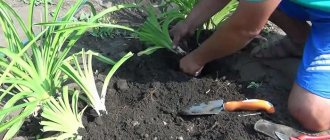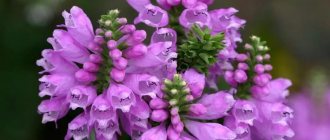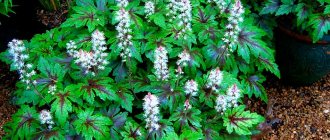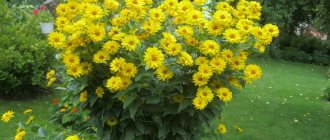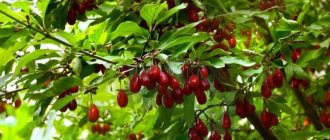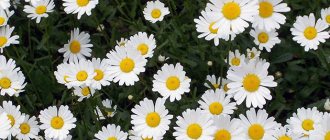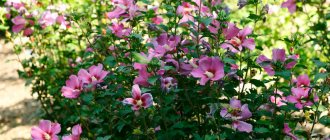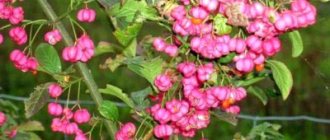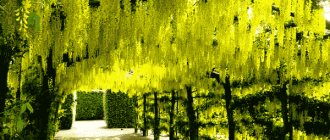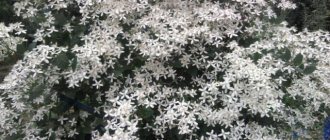Description of the flowering shrub Kolkvitsia
Kolkwitzia amabilis is a monoecious (which bears flowers of both sexes) deciduous shrub of the Honeysuckle family. The homeland of the plant is Western China. It was brought to Europe more than 100 years ago, but is not yet widely used in landscape design. One of the names of the plant is Pleasant Colquitia.
Main species characteristics:
- A multi-stemmed shrub with a spherical crown and abundant basal shoots. Its height is up to 3 m, width - up to 4 m. A cultivated plant can be more compact - 1.5 - 2 m.
- At first, the straight branches, growing, bend in the form of an arch, bending to the ground under the weight of the flowers.
- The bark of the shoots of the lovely kolkvitia is thin, reddish-brown and peels off in plates.
- The wide leaves are oval in shape, pointed towards the top. They are located opposite. Their length is 3 - 7 cm. Their edges are shaggy. The upper part of the leaves are dark green in color, becoming lighter towards the base. In autumn they turn bright yellow and red.
- The flowers, approximately 1.5 cm in size, have a light aroma, are collected in corymbose inflorescences and are located at the ends of the shoots. Their shape is bell-shaped, five-lobed. The color of the lovely colquitia flower is light pink with a lilac tint, and there is an orange pattern inside the throat. Pedicels are drooping.
- Single-seeded fruits ripen in autumn. They are dry, covered with bristles and look like a brown box. They produce seeds that have poor germination.
This description and specific features of the lovely kolkvitia are detailed in the photo:
Important! The plant is named after the German botanist Richard Kollkwitz.
The shrub grows well and blooms profusely in any garden soil. An illuminated sunny place is preferable for it; the culture does well in partial shade. Colquitia charming is characterized by the properties of frost resistance and endurance in an urban environment.
How and when does kolkvitsia bloom?
The blooming lovely kolkvitsia looks very elegant. Its soft pink flowers, reminiscent of mother-of-pearl, are arranged in cascades on hanging branches. The bush blooms profusely: the foliage behind the flowers is almost invisible. They attract insects with their sweet aroma.
The growing season of the plant is mid-April to November. The lovely kolkvitia blooms from the age of five in spring or summer, depending on the climate of the growing area. In the middle zone it blooms in early July, later than other ornamental shrubs. Flowering lasts more than three weeks.
Attention! It is characteristic of the flowers of the charming colquitia that they do not fade, but fly around while in bloom.
Application in landscape design
According to reviews of experts in the field of landscape design, the charming colquitia looks most advantageous as a tapeworm in various compositions:
- An accent element on a green lawn.
The lovely Colquitia is planted individually on a well-groomed area. By trimming, it is given a neat spherical or fountain-shaped shape. Advice! The lovely colquitia goes well with the texture of stone and dark wood. - Group plantings of lovely kolkvitia. A shrub planted as a hedge looks impressive. In this way, you can add privacy to a relaxation area in the garden or grandeur to the central entrance of a personal plot. The combination of different varieties of the charming kolkvitia in group planting creates non-contrasting color transitions from dark pink to almost white.
- Contrasting compositions. The light color of the flowers of the charming kolkvitia is emphasized by darker deciduous, coniferous or brightly flowering plants. In autumn, its yellow or red foliage sets off the less colorful shrubs. Vegeila and hawthorn emphasize the delicacy of the flowers of the crop.
- Mixborders.
Delicate pink flowers of the lovely colquitia highlight the central part of the shrub group. It is placed as a tapeworm and surrounded by lower plants. Important! A mixborder is a free-form flowerbed.
Kolkvitsia: growing in the garden, types and varieties
Author: Natalya February 22, 2021 Category: Garden plants
Kolkwitzia (lat. Kolkwitzia) is a monotypic genus of flowering plants of the Linnaean subfamily of the Honeysuckle family. The only representative of the genus is the pleasant shrub (Kolkwitzia amabilis), which grows in the mountainous regions of Central China and other places with a temperate climate. The plant received its name in honor of the German botanist Richard Kollkwitz. The plant was brought to Europe in 1901, and for the first time the kolkvitsia flower bloomed in an unusual European climate in 1910.
Varieties of wonderful collection
Few varieties of this plant have been selected. They are highly decorative. Heat-loving and not hardy enough, varieties of the lovely kolkvitia require special conditions for planting and care. Varieties Pink Cloud, Rosea and Dreamcatcher are suitable for growing in the temperate continental climate of the middle zone.
Pink Cloud
Pink Cloud blooms more profusely than the original variety. The shrub is characterized by its smaller size. At the age of five, it reaches a height of 0.8 m. Its maximum size is 2x2 m. The variety is frost-resistant and drought-resistant. Its shoots grow vertically, and the emerging pale pink flowers almost completely hide them.
Rosea or Rosea (Rosea)
Rosea begins to bloom with bright pink bells, which, as they bloom, acquire a light pink, almost white color. The shrub lends itself well to pruning. It is formed into perfect balls that are completely covered with flowers. The shoots of the crop hang beautifully in the form of a fountain. In autumn the leaves turn orange.
Dream Catcher Beauty Bush
A common name for this variety is Maradco. Its main difference from other varieties is the more compact size of the shrub. The golden-orange hue of the leaves and sparse flowering are another varietal feature of this lovely plant. The culture is also disease resistant.
Important! Lovely kolkvitia can be grown in the middle zone, in the southern regions of Russia, as well as in the Moscow region.
Varieties
Today there are three main varieties:
- Kolkwitzia amabilis Graebn, or lovely one. Blooms with snow-white flowers. It's a pleasure to look at this flowering bush!
- Kolkvitsia lovely Pink Cloud. The frost resistance of this beautiful plant is truly admirable. It's hard to imagine this beauty being so unpretentious. Lovers of bright colors especially like it. The color of the petals is very pleasant. Looking at it, it becomes clear why it is called the “pink cloud”.
- Colquitia rosea - developed relatively recently. The bush is strewn with pink flowers, quite large.
In a temperate climate, the plant may be slightly smaller than in natural conditions in its homeland. Usually does not exceed one or one and a half meters.
Peculiarities of reproduction of colquitia
Charming kolkvitia, like other perennial shrubs, is propagated by seeds, cuttings, layering or division.
Seeds
The seeds of the plant have low germination rate - 25 - 35%, which must be taken into account when choosing this method of propagation. When growing this way, special attention is paid to the nutrient substrate. It is made up of peat and sand, taken in equal proportions.
Seeds are planted in early April. To protect the shoots from late frosts, they are placed in a greenhouse or at home in a pot. The sprouts sprout by the beginning of summer, and in August they grow by almost 20 cm.
Procedure for propagating the lovely kolkvitia by seeds:
- Prepare the seeds. To do this, the seeds are subjected to stratification for two months: they are stored in the refrigerator at a temperature of 1 - 3 0C in a sealed bag with damp vermiculite or a napkin. To speed up germination, seed material is soaked for 10 minutes. in sulfuric acid.
- Deepen the seeds into the substrate no more than 0.5 cm and water generously.
- The next spring after planting, it is important to pick up the plant and plant it in a permanent place.
Attention! Seedlings have low resistance to frost, so they are not planted in open ground in the fall.
By layering
The most effective way to propagate the lovely kolkvitia is by layering. The sequence of actions is as follows:
- Choose a shoot that grows outward from the bush.
- A small ditch is dug under it.
- The shoot is tilted and placed in a groove.
- Where the shoot touches the ground, it is lightly cut and treated with a growth stimulator.
- The shoot is fixed with a pin and sprinkled with soil, leaving the top free.
- The soil is constantly kept slightly moist during the summer.
- The following spring, after rooting, the layerings of the beautiful kolkvitia are separated from the mother bush and transplanted to a permanent place.
Cuttings
Important! Due to their low frost resistance, propagation of the lovely kolkvitia by cuttings is possible only in areas with mild winters.
Cuttings are carried out using one of the following methods:
- Lignified cuttings. At the end of autumn, a lignified twig is cut from the charming kolkvitia shrub and buried in a shaded place. By winter, the cuttings are mulched with hay, straw or leaves. With the arrival of spring they are opened. Over the summer, the shoots will take shape and take root. The following spring, the young plant is transplanted to the desired location.
- Annual cuttings. In early spring, one-year-old shoots are separated from the mother bush and cut from them. Then, for rooting, they are planted in containers with soil mixture and kept in a warm place. At the beginning of summer, the cuttings are taken outside into the shade and watered regularly, preventing the soil from drying out. After the young shoots appear, they are transplanted into open ground in a shaded place and continue to be watered. Before the onset of winter, plants are covered. In the spring, the young beautiful kolkvitia is transplanted to a permanent site.
Dividing the bush
It is advisable to use the method of propagation by dividing the bush when transplanting the lovely colquitia. They do it this way:
- The plant is carefully dug up.
- Conduct a thorough inspection of the root system. Rotten and dry roots are removed.
- The bush is divided into 3 - 4 parts so that each division consists of a healthy shoot and good roots.
- The sections are treated with garden pitch or sprinkled with crushed coal.
- New plants are planted in pre-prepared holes according to the scheme adopted for planting.
Attention! The best time to divide the shrub is early spring.
How does kolkvitia propagate by seeds?
Growing colkvitia from seeds Photos of seedlings
Seeds should be planted in the ground before winter, but you can also plant seedlings in a greenhouse in the spring.
Related article: Marigolds: growing from seeds, planting and care, varieties and properties
When planting in spring at the end of March, cold stratification is carried out for 2 months.
To do this, the seeds must be stored in the refrigerator (stage 1: two weeks in the freezer, stage 2: on the refrigerator shelf).
Then the seeds are sown in large containers or in separate pots to a depth of one cm. They are grown in a greenhouse and planted in the ground in the spring of next year.
Planting and caring for kolkvitsia in open ground
Growing colquitia in the middle zone, in the south of Russia and in the Moscow region requires compliance with the rules of planting and caring for the plant. Agrotechnical measures for this crop are not complicated and are accessible even to novice gardeners.
Recommended timing
It is recommended to plant the lovely kolkvitia in open ground in the spring, when the soil in the root layer has warmed up well:
- end of March - for the southern regions;
- early April - for the middle zone;
- mid-to-late April – for the Moscow region and territories located to the north.
Attention! In areas with mild winters, autumn planting of the lovely colquitia is possible.
Site selection and soil preparation
The place for planting the lovely kolkvitia must meet the following characteristics:
- be well lit, but openwork partial shade is allowed;
Important! In the shade, kolkvitsia blooms sparingly.
- protected from gusts of wind (for example, against the wall of a building or fence);
- groundwater should not lie too high, stagnation of rain or snow water is not allowed;
- The shrub develops well and blooms on fertile, loose and weed-free soil: ideally it should contain humus, sand, compost and leaf soil.
Important! Alkaline or neutral soil is preferable for sweet kolkvitia. Acidic soils are limed or wood ash is added to them.
How to plant a lovely columbine
For planting, choose one- or two-year-old healthy seedlings with well-developed roots. In order for the lovely kolkvitsia, regardless of the chosen variety, to take root well and bloom thickly, adhere to the following planting algorithm:
- Prepare a hole measuring 60x60x60 cm. When planting in groups, the distance between bushes should not be less than 1.5 m.
- Pour a fertile mixture of soil, humus and sand into the bottom of the hole in a ratio of 2:1:1.
- Place a seedling of the lovely kolkvitia in the hole, making sure that its root collar is not buried.
- Spread the roots of the plant.
- Adding soil in portions and watering each layer with a small amount of water, fill the planting hole.
- Lightly compact the trunk circle.
- The final stage of planting is watering and mulching the soil around the seedling.
How to plant kolkvitsia in the Moscow region
The procedure for planting charming coli in the Moscow region and Moscow region does not differ from the generally accepted scheme. Prepared seedlings are placed in holes, covered with soil and watered. The soil must be mulched. This helps retain soil moisture and protects the roots from overheating.
Description of the lovely collection
Kolkvitsia is a highly branched perennial shrub with drooping shoots bending in an arc, growing up to two meters in height. The plant belongs to the Honeysuckle family. The shrub is monotypic, that is, in nature there is only one type of such plant.
Characteristics and description of the Khlebosolny tomato variety, its yield
The shrub is native to the mountainous regions of China. The luxurious bush received its name in honor of the German botanist Richard Kolkwitz. It has been grown as a cultivated plant since 1901. Its first flowering as a garden shrub was observed in 1910, so kolkvitsia has been pleasing garden lovers for more than a hundred years.
With proper care, after 7–8 years, an overgrown bush can be used to form a new garden decoration - a spreading tree in the shape of a ball. In this regard, before planting the plant, you need to carefully choose a place, taking into account that in the future the bush will need a lot of free space. It is better for him to leave a circle with a two-meter diameter for growth.
Old and young shoots of shrubs differ in appearance. Old shoots are covered with dark scaly bark, while young shoots are green and pubescent. Initially, the branches grow only upward, but as they grow, they begin to take the shape of an arc leaning towards the ground.
In spring, the bush is covered with oval green leaves pointed to the edge. The bottom of the leaves is covered with villi and is lighter in color than the top.
The bush blooms in mid-summer. Paired buds grow at the ends of the branches. The flowers are bell-shaped, delicate pinkish-white in color with a pearlescent sheen. The bases of the petals are crossed by yellowish veins, forming a kind of mesh. All flowers and buds are located on separate pedicels, which are collected into small inflorescences.
The bush begins to bloom in the second year of life, but its decorative potential becomes fully apparent after 7–8 years. The flowering is so abundant that the leaves are practically invisible due to the flowers and buds. It is during this period that the owner of the collection will be able to enjoy a real “flower cloud”.
With the beginning of autumn, the flowers on the bush are replaced by small, about 0.6 cm, seed pods. The shoots turn yellow. But the foliage becomes multi-colored , which enhances the decorative effect of the plant.
Colquittia transplant
An overgrown shrub can be replanted every five to six years to a new location. This is best done in the spring, when the air temperature stabilizes. This way the plant will take root well and produce young shoots. The lovely Colquitia tolerates transplantation to a new place well. It takes root quickly and blooms well. At this time, you can propagate the bush by division. Algorithm for transplanting an adult plant or seedling with a closed root system:
- The shrub is carefully dug up or removed from the container, being careful not to damage its roots.
- Prepare a planting hole with a size exceeding the dimensions of the root system with a lump of earth.
- Pour a soil mixture enriched with nutrients into the hole.
- The bush is placed in a planting nest, its roots are covered with earth, avoiding deepening the root collar. The soil is compacted.
- Transplanted kolkvitsia requires abundant watering and mulching of the tree trunk circle.
Kol'kvitsia in the Moscow region
In areas with a cool climate, young shoots of kolkvitia do not have time to ripen before winter, so in the spring the plant often has dry ends on its branches that need to be cut off before flowering begins. To speed up the ripening of shoots, after flowering has ended, you need to greatly reduce watering, stop feeding the columbine and mulch the soil around the bush to a depth of 5-10 cm with compost or peat mixed with leaves or sawdust. This measure protects the plant’s root system from freezing and stimulates the plant to accumulate nutrients for the winter. In late autumn, unripe growths are removed, leaving woody shoots and only a small number of young growths on the bush.
Features of cultivation
Lovely colquitia can withstand frosts down to -15 0C. According to reviews from domestic gardeners, it is not afraid of short-term frost down to -30 0C.
Watering and fertilizing schedule
The lovely Colquitia can withstand short-term drought, but for good flowering and development it needs regular watering. Water the shrubs without allowing the soil to dry out, using water that has been settled and heated in the sun. The best time for the procedure is evening.
Important! The rule for feeding the charming kolkvitia is: it is better to underfeed the plant than to overfeed it.
An excess of fertilizers reduces the winter hardiness of the plant and activates growth processes, which lead to a deterioration in the flowering of the shrub. Feeding is applied according to the following schedule:
- The crop is fertilized with rotted organic matter and mineral additives 2-3 times during the growing season;
- if the plant develops poorly, use liquid fertilizers in the form of superphosphate (40 g per bucket of water) or mullein infusion (1:10).
Consumption of the nutrient mixture is 10 liters per bush.
Pruning columbine
The lovely Colquitia needs gentle formative pruning. Try not to cut off the side and top branches, as this may negatively affect the flowering of the bush. In summer, the immature tips of the shoots are shortened, which helps strengthen their bases.
Anti-aging pruning is carried out after the lovely kolkvitsia has faded. Old shoots are cut to the base. From spring, the plant will direct all its efforts to forming the growth of young branches. Next year they will begin to bloom.
Sanitary pruning is carried out with the onset of spring. At the same time, branches damaged by frost and pests are removed.
How to cover kolkvitsia for the winter
Successful wintering of the charming kolkvitia, especially in the middle zone and Moscow region, as well as in areas with severe frosts, is possible only with proper preparation. It starts in the fall, without waiting for early frosts:
- reducing watering of shrubs;
- stopping fertilization after flowering ends;
- mulching the root zone with leaf, compost with sawdust or peat for the winter, laying a layer at least 5-10 cm thick, which protects the soil from freezing.
Advice! The radius of the soil mulching zone around the charming shrub should be equal to or greater than the size of the projection of its crown.
The best protection for a plant from frost is its shelter for the winter. The crown of young plants is wrapped with non-woven covering materials or kraft paper. It is effective to bend the bush to the ground and then lay spruce branches on it. Then a layer of snow up to 30 cm thick is thrown on top, under which the plant will safely overwinter. With the onset of warm weather, the charming kolkvitsia must be freed from covering materials in order to prevent it from rotting.
Important! After freezing, the lovely colquitia has the property of being completely restored, provided that the root system of the plant is not damaged. Unripe young shoots are susceptible to freezing, so they are all removed in the fall.
It is possible to grow a flowering, healthy, disease-resistant shrub, as in the photo, only with proper planting and proper care of the kolkvitsia.
Cuttings
This procedure greatly simplifies the task of the gardener. At the same time, cuttings are an easier and faster way to get a young plant. To do this, you will need to cut off the selected branches in June and soak them in a rooting solution. After this, the cuttings are planted in a greenhouse. It's very simple to make: place several wire arcs and stretch the film. Until next spring, the cuttings will take root perfectly. If you live in a region with harsh winters, then it is better to plant cuttings at home and plant them in the garden when spring comes. Approximately 45% of plantings usually take root and grow quickly, so it makes no sense to plant 1-2 cuttings.
Pests and diseases
The shrub has properties of resistance to diseases and pests. But in dry and hot weather it can be attacked by spider mites, thrips, aphids and caterpillars. In this case, the crown is treated with a solution of insecticides for flowering plants.
The following problems may occur when growing a plant:
| Problem | Cause | Recommendations for elimination |
| Poor flowering | Insufficient lighting. | Remove shading objects or replant the bush. |
| Improper use of fertilizers. | Adjust the feeding scheme. | |
| Low nutritional value of the soil. | Fertilize the bush. | |
| Dying of young shoots | Freezing of the plant in winter. | · remove damaged branches; · Be sure to cover the bushes for the winter. |
| Root system rotting | Stagnation of moisture in the soil. | Make drainage. |
general description
It belongs to the Honeysuckle family, but usually blooms later than its other representatives, in June or even early July. At the same time, it blooms profusely and for a relatively long time, up to 3 weeks. In nature, the shrub has a more impressive size and grows up to 3m. In garden culture you can rarely find specimens taller than 2 m, more often 1-1.5 m. It has a spreading shape due to the shoots drooping with age. It begins to bloom from 4-6 years of age (it happens earlier) with small pink flowers collected in corymbose inflorescences with a darker orange mesh in the throat and a pleasant aroma. By August-September it forms bristly ovoid seed pods with small light brown seeds. The rich green foliage turns bright yellow in the fall.
Approximately half of the seeds in the boxes remain unripe, and another half of the remaining ones do not sprout. Therefore, the germination of seed material should be estimated at 25%.
Kolkvitsia
The flowering plant Kolkwitzia belongs to the monotypic genus of the subfamily Linnaeaceae of the Honeysuckle family. This genus is represented by only one species - Kolkwitzia amabilis, which is a shrub.
In nature, such a plant can be found in the mountainous regions of Central China, as well as in other regions with a temperate climate. This shrub was named after the German botanist R. Kolkwitz.
It was brought to European countries in 1901, but the first flowering of such a plant in unusual conditions was noted only in 1910.
Features of collection
Kolkvitsia is a deciduous shrub that reaches a height of 2–3.5 meters.
On the surface of young stems there is pubescence, consisting of short hairs, while old shoots are covered with brown-red bark, it peels off in plates, which is typical for all representatives of the honeysuckle family.
If conditions are favorable for colquitia, then it develops dense root shoots. Opposite paired leaf plates of oval shape and rich green color can reach 3.5–8 centimeters in length. In autumn the foliage turns yellow.
Five-lobed graceful bell-shaped flowers have a light yellow color on the inner surface and pink on the outer surface. The unusually lush flowering lasts for about half a month in spring and summer. There are so many flowers that it is impossible to see the foliage because of them. The bristly fruits are dry.
What time to plant
To plant colquitia, you should choose spring time, and the soil should warm up well.
The planting site should be sunny and protected from strong gusts of wind; if desired, you can grow kolkvitsia in slight shade.
Remember that areas that are covered with melt water for a long time in the spring are not suitable for planting this shrub. The soil should be nutritious, light, neutral and well-drained.
Landing Features
The planting hole should be prepared half a month before the scheduled planting day. It should be about 0.4 m deep, while its length and width can vary from 0.5 to 0.6 m. Then the hole should be filled with a soil mixture, which should include sand, turf soil and humus (1:2 :2). Within half a month, this mixture will be thoroughly compacted and settle.
It is best to choose seedlings for planting that are 1 or 2 years old. Immediately before planting the plant in open soil, it will be necessary to shorten the roots that are too long.
Then the seedling is placed in a prepared hole, which is filled with the same soil mixture, but you need to add 1 more bucket of wood ash or 80 to 130 grams of complex mineral fertilizer into it. Don't forget to compact the soil well. The planted plant needs abundant watering.
After the liquid is completely absorbed into the ground, the surface of the tree trunk circle should be covered with a layer of mulch.
Caring for colquitia in the garden
When growing kolkvitia, it is important to take into account that the soil in the tree trunk circle should not dry out under any circumstances. For irrigation, use settled water, which should not be cold.
In order for the bush to develop and grow normally, it needs to be fed in a timely manner. In the spring, an infusion of mullein (1:10) is used for this purpose, while in the first summer weeks a solution of double superphosphate is added (30 to 50 grams of the substance per 10 liters of water). For 1 bush take 10 liters of nutrient mixture.
After flowering has finished, the plant can no longer be fed, but formative pruning will need to be done. At the very end of the season, it is necessary to remove all young shoots that did not have time to ripen by the beginning of the winter period.
In spring, you need to carry out sanitary pruning; to do this, you should cut out all branches and stems that are injured, dried out, damaged by frost, pests or disease, as well as those that thicken the bush.
Throughout the summer period, it will be necessary to promptly remove root growth, which grows extremely intensively in conditions favorable for colquiculture.
Transfer
This shrub tolerates transplantation very well.
To do this, the bush must be carefully dug up, trying not to injure its root system, and then it is carefully transferred to a prepared planting hole, which should be covered with an earth mixture rich in nutrients. The transplanted bush needs abundant watering. After the liquid is completely absorbed into the soil, the surface of the tree trunk circle will need to be covered with a layer of mulch.
Reproduction of Colquitia
Such a plant can be propagated by seed (generative) method, as well as vegetatively - by layering, cuttings and dividing the bush.
Seed method
Growing colquitia from seeds takes quite a long time and does not always end successfully. For stratification, the seeds are placed in the refrigerator on a vegetable shelf for 3 months.
They are sown in April, using a long container filled with a soil mixture that includes peat, garden soil and sand. Cover the container with film and move it to a warm place.
The seedlings will need to be grown indoors until the next spring.
Dividing the bush
The shrub can be propagated by dividing the bush during transplantation. The roots of a dug plant must be carefully inspected, and dried and rotten roots should be removed.
Then the bush is cut into several parts, it should be taken into account that each section must have powerful stems and developed roots. The cut areas must be sprinkled with crushed coal. Such divisions should be planted in prepared holes.
This procedure is carried out in the same order as the initial planting.
By layering
Rooting cuttings is the most effective method of propagation. The selected shoot must be bent to the soil surface and placed in the prepared groove. In the place where the shoot comes into contact with the soil, you need to make an incision and treat it with a growth stimulating agent.
The shoot is fixed in this position and covered with soil, while its upper part should remain free. During the summer, do not forget to water the cuttings in a timely manner so that the soil around it is always slightly moist. After a short time, roots will grow from the buds that are underground.
It will be possible to separate such a layer and plant it in a new place only next spring.
Propagation of kolkvitia by cuttings
Propagation by cuttings is carried out in spring and autumn. So, in May, semi-lignified cuttings should be cut, which are planted in a tub filled with soil mixture for seedlings. For the winter, this container can be placed in the basement if desired. Cuttings prepared in the fall take root better.
To do this, cuttings cut in the autumn must be wrapped in polyethylene and put in the basement; in the spring, they are treated with Kornevin and planted in a greenhouse, where they will remain until the next spring. To plant in open soil, such a seedling must be taken along with a lump of earth.
1 or 2 years after planting in a permanent place, these shrubs will begin to bloom.
Diseases and pests
This plant is resistant to diseases and pests, but if the weather is hot, spider mites, aphids or thrips can settle on the bush.
In order to get rid of these pests that suck the juice from the plant, use an acaricide solution (Aktar or Actellika), 2 or 3 treatments will be needed, with a break between them of 7 days. Caterpillars can also settle on the kolkvitia and eat its leaves.
If their quantity is small, manual collection should be done. If there are a lot of caterpillars, then spray the bush with an insecticide.
After flowering
If, according to weather forecasters, the next winter will have little snow and very cold, it is necessary to cover the kolkvitsia.
After the air temperature has settled at sub-zero levels, it will be necessary to cover the tree trunk circle, the size of the projection of the crown, with a layer of peat, wood chips or bark, the thickness of which should be from 10 to 12 centimeters.
If the bush is not yet 5 years old, then it is bent to the soil, covered with spruce branches, and in winter a layer of snow is thrown over it.
If desired, the crown of the plant is wrapped in spunbond or lutrasil; it is removed only in the second half of April, after the air temperature is above zero degrees. If the winter turns out to be extremely frosty, the colquizia may freeze, but in the spring it recovers extremely quickly. At the same time, experienced gardeners note that the older the plant, the higher its frost resistance.
Growing in the Moscow region
If kolkvitia is grown in regions with a cold climate, then its young shoots do not always have time to ripen before winter, and therefore in spring you can often see dried out tips on the bush. They should be cut before the plant blooms.
In order for the shoots to ripen faster when the bush fades, you need to reduce watering, stop fertilizing, and also cover the tree trunk circle with a layer of mulch (peat or compost combined with sawdust or leaves), the thickness of which should be from 5 to 10 centimeters. This will not only protect the plant’s roots from winter frosts, but will also force it to accumulate nutrients.
In late autumn, almost all young growth should be cut off. In this case, lignified stems with a small number of young growths should remain on the bush.
Types and varieties with photos
There are only 2 varieties of lovely kolkvitsia, namely:
- Rosea . The color of the flowers is bright pink.
- Pink Cloud . The color of the flowers is deep pink.
Source: https://rastenievod.com/kolkvitsiya.html

